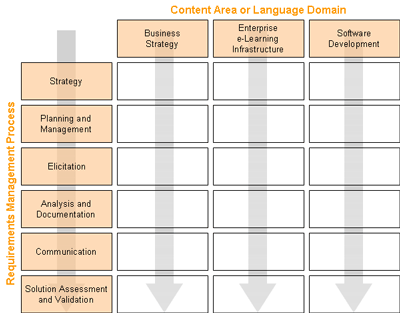
Fill-in-the-blanks: A Process / Content Framework
If you’ve read the previous entries in this blog, you have seen that we’ve been building up to something, and this new entry will hopefully bring us to our first conceptual plateau, upon which there is much more to build.
What we’ve done so far is to reorient our view of requirements and the BABOK, by going from this (based on BABOK 1.6):

to this (based on IIBA guidance on BABOK 2.0 direction and the concepts from the three previous blog entries):

Following the previous blog entry about content vs. process, we are naturally led to the above structure which manifests that distinction and also provides a framework within which we can indicate the appropriate methods, tools, techniques, and standards for the corresponding process phase, within the corresponding language domain.
For example, in the Software Development x Elicitation cell, we would typically find UML, prototyping, consideration of legacy systems, etc.; while in the Enterprise e-Learning Infrastructure x Elicitation cell, we might find multimedia complexity requirements analysis, consideration of training data privacy laws, task analysis, etc.
This view brings up some interesting questions about
- Ownership of the process itself (process design, continual improvement, and governance)
- Whether this view contributes to or hinders senior management’s ability to obtain a dashboard view of the benefits, costs, and risks related to current requirements management efforts
- The potential benefit to the enterprise as a whole should this view be adopted by managers and individual contributors involved in managing or meeting requirements
We’ll tackle one of those in the next entry. Meanwhile, I, and I am certain your colleagues, would love to hear your comments.
Polkadot mushroom bars
… [Trackback]
[…] There you will find 73056 more Information to that Topic: batimes.com/articles/fill-in-the-blanks-a-process-content-framework/ […]